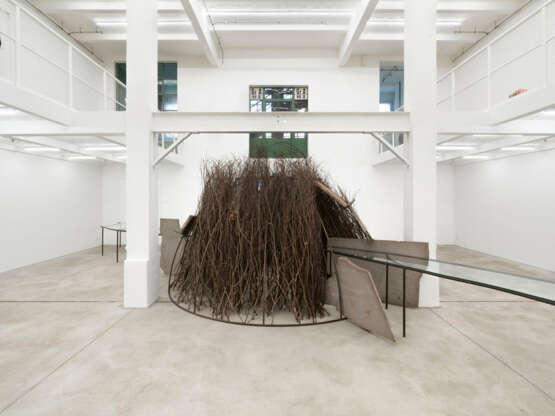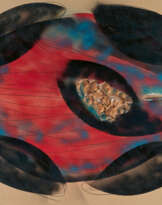ID 1435714
Lot 35 | Mario Merz. Albero Grande Solitario
Estimate value
€ 200 000 – 300 000
1925 Milan - 2003 Turin
Title: Albero Grande Solitario.
Date: 1995.
. Technique: Steel, glass, stone, brushwood.
Igloo: 215 x Ø400cm, tables each: 88 x 560 x 82cm (total measurement: 270 x 1000 x 530cm).
This work is accompanied by a certificate from the archives of Mario Merz, Turin, in copy. It is registered there under the number 927/1995/IG.
Provenance:
- Company collection Germany (directly from the artist)
Exhibitions:
- Galerie hlavního mesta, Prague 1995/96
- Galerie Jule Kewenig, Frechen 1996/97
- Moderna Galerija, Ljubljana 1997
- Aargauer Kunsthaus, 1997
- Skulpturenmuseum Glaskasten, Marl 1997
- Fundacao de Serralves, Porto 1999
- Galerie Jule Kewenig, Cologne 1999/2000
- Institut d'art contemporain, Villeurbanne 2000
- Galerie Kewenig, Cologne 2004
- Galerie Kewenig, Palma 2007
- Galerie Kewenig, FIAC, Paris 2010
- Art Basel Unlimited, Basel 2014
- BEEAH Headquarters, Dubai 2023
- Konrad Fischer Galerie, Berlin 2024
Literature:
- Fondazione Merz (ed.): Mario Merz, Igloo, Catalogue Raisonné, Vol. 1, Turin 2024, cat. rais no. 124, ill.
- Exhib.-cat. Mario Merz. Tri instalace, Galerie hlavního mesta, Prague 1995/96, ill.
- Exhib.-cat. 47. Esposizione Internazionale d'Arte/La Biennale di Venezia. Futuro Presente Passato, Milan 1997, p. 397, ill.
- Exhib.-cat. Epicenter Ljubljana, Moderna Galerija, Ljubljana 1997, p. 35, ill.
- Exhib.-cat. Voglio vedere le mie montagne. Die Schwerkraft der Berge 1775-1997, Aargauer Kunsthaus, Aargau 1997
- Exhib.-cat. Ausgestellt - Vorgestellt III: Mario Merz für Peter Wüthrich, Skulpturenmuseum Glaskasten, Marl 1997, p. 9, 11, 13-15, 19, ill.
The sculpture can be viewed in a warehouse in Cologne by prior appointment.
- By the main protagonist of the avant-garde 'Arte Povera" movement in Italy
- Monumental installation of museum quality
- Since the 1960s, 'Igloo' stands for retret, shelter, and collective memory in Merz's oeuvre
"Als ich den Iglu machte, habe ich mit Einbildungskraft gehandelt, denn der Iglu ist nicht nur die Elementarität der Form, sondern auch ein Ausgangspunkt für die Phantasie." (Mario Merz in einem Interview mit Suzanne Pagé und Jean-Christophe Ammann, zit. nach Ausst.-Kat. Mario Merz - ARC, Musée d'art moderne de la ville de Paris / Kunsthalle Basel, 1981, o.S.)
Der Meister der Arte Povera
Die zweite Hälfte der 1960er Jahre ist geprägt durch fundamentale Infragestellungen und Konfrontationen von politischen Systemen und gesellschaftlichen Lagern. Auch in künstlerisch-ästhetischer Hinsicht gibt es Aufbrüche; die informelle Malerei auf der Leinwand reicht vielen Künstlern nicht mehr aus. Das "wahre Leben" bricht in die Kunst ein und verschränkt sich mit ihr. 1967 zeigt eine Gruppe junger Künstler in Genua Werke, in denen alltäglichste, "arme" Materialien verarbeitet werden. Der Kurator Germano Celant prägt hierfür den Namen "Arte Povera".
Zum führenden Vertreter dieser Kunstrichtung wird Mario Merz. Der Sohn eines Architekten und Medizinstudent kommt 1945 wegen seiner antifaschistischen Aktivitäten in Haft. Hier beginnt Merz zu zeichnen und wendet sich, wieder in Freiheit, ganz der Kunst zu. Als Autodidakt malt Merz zunächst, beeinflusst vom Informel und vom abstrakten Expressionismus. Aber 1968 findet er seine Form in der Installation: Das erste Iglu entsteht. In dieser Urform der Behausung findet Mario Merz eine Metapher, die Natur und Kultur verbindet, die aber auch das Nomadentum des menschlichen Lebens an sich versinnbildlicht. Mario Merz entdeckt die künstlerischen Möglichkeiten von formbaren Neonleuchten, die er häufig mit einem ebenso wiederkehrenden Element seiner Kunst kombiniert: der Zahlenreihe der Fibonacci-Folge. Diese, der Natur innewohnende mathematische Gesetzmäßigkeit, wird in seinen Arbeiten ebenso prägend wie das Iglu oder die Form der Spirale. Dabei schafft Merz seine eigene Metaphorik und Ikonographie, sein Werk lässt aber jeden Raum für freie Assoziationen. Seine erste museale Einzelausstellung richtet die Kunsthalle Basel Mario Merz 1975 aus; seither ist sein Werk weltweit in führenden Museen und prominenten Sammlungen präsent. Der Einfluss, den die Arte Povera und Mario Merz speziell auf die heutige ästhetische Wahrnehmung genommen haben, ist kaum zu überschätzen.
Der "Albero Grande Solitario"
Von den Dimensionen her ist dieses Iglu durchaus komfortabel: 4 Meter Durchmesser und eine Höhe von 2,15 Metern bieten reichlich Platz. Die Wände aus Reisig schaffen einen Sichtschutz nach außen, aber das Gewölbe ist nicht wirklich bedeckt. Die Leichtigkeit der vegetabilen Reisigbündel wird kontrastiert von massiven, kompakten Steinplatten, deren Oberflächen aber geglättet sind und die in fragil wirkenden Konstruktionen entweder auf ihren schmalen Kanten stehen oder auf anderen Platten aufliegen. Den schnell gewachsenen, jungen Ästen des Reisigs wohnt aber auch eine andere zeitliche Komponente inne als den in früheren Erdzeitaltern geformten Steinen. Das Iglu hat - höchst ungewöhnlich für diese Art des Schutzraums - zwei Zugänge. In beide führt eine Konstruktion hinein, die Mutmaßungen erlaubt. Es sind gläserne, leicht geschwungene "Tische", die, an den Zugängen jeweils von Steinplatten flankiert, wie ein Band durch den Reisigbau schneiden. Die spiegelnde Oberfläche des klaren Glases lässt an Wasser denken. Eine Wasserader, die den "großen Solitärbaum" nährt? Oder strahlt das unsichtbare Innere des Iglus hier sichtbar in den Raum aus? Die Glaskonstruktionen versperren jetzt aber den Zugang zu der Reisighöhle. Um hineinzugelangen, muss der Betrachter (gedanklich) unter den Tischen entlang krabbeln - das Glas erlaubt die Benutzung des Tischs als Steg wohl nicht. Der "Albero Grande Solitario", ursprünglich 1995 für eine institutionelle Ausstellung in Prag geschaffen, will weder belehren noch etwas behaupten. Wie alle Iglus des Künstlers kann auch dieses der Ausgangspunkt für die Phantasie der Menschen sein.
| Auction house category: | Post War Objects |
|---|
| Auction house category: | Post War Objects |
|---|
| Address of auction |
VAN HAM Kunstauktionen GmbH Hitzelerstr. 2 50968 Köln Germany | ||||||||||||||
|---|---|---|---|---|---|---|---|---|---|---|---|---|---|---|---|
| Preview | |||||||||||||||
| Phone | +49 221 92586215 | ||||||||||||||
| Fax | +49 221 92 58 62 4 | ||||||||||||||
| Buyer Premium | 32% | ||||||||||||||
| Conditions of purchase | Conditions of purchase | ||||||||||||||
| Business hours | Business hours
|





